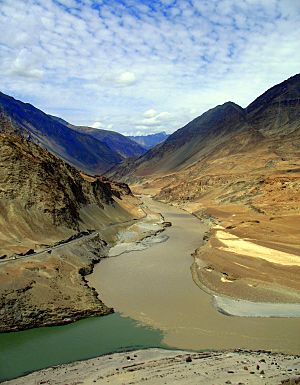Zanskar Gorge facts for kids
The Zanskar Gorge is an amazing natural wonder located in the Zanskar region of Jammu and Kashmir. Imagine a deep, narrow canyon carved by a powerful river! The gorge has very tall, steep walls, some reaching up to 600 meters (about 2,000 feet) high! The Zanskar River flows through it, and in some spots, it's only 5 meters (about 16 feet) wide. This river is a tributary of the mighty Indus River.
Contents
Exploring the Zanskar Gorge
The Zanskar Gorge is a very special place, especially in winter. It provides a unique way to reach the Zanskar Valley. However, this path is only open when the river freezes solid.
The Chadar Trek: A Winter Adventure
During the cold winter months, the Zanskar River freezes over, creating a thick sheet of ice. This frozen path is known as the "Chadar" (which means "sheet" or "blanket" in the local language). The Chadar Trek is a famous adventure for hikers.
Walking on Ice: The Chadar Trek Experience
People walk along the frozen river, sometimes on the ice itself and sometimes climbing over rocks next to it. It's a challenging journey, but it offers incredible views of the towering gorge walls. Trekkers often camp in caves or on sandy riverbanks along the way.
Why is the Chadar Trek Important?
For a long time, the Chadar was the only way for people in the Zanskar Valley to connect with the outside world during winter. It was used by locals for trade and travel when heavy snow blocked other routes. Today, it's mostly a popular trek for adventurers.
The Zanskar River
The Zanskar River is a vital part of the gorge. It's a fast-flowing river that carves its way through the mountains.
River's Journey: From Mountains to Indus
The Zanskar River starts high in the Himalayas. It flows through narrow valleys and deep gorges before joining the Indus River. The Indus River is one of the longest rivers in Asia.
How the Gorge Was Formed
Over thousands of years, the powerful flow of the Zanskar River slowly eroded the rock. This process, called erosion, carved out the deep, narrow gorge we see today. The hard rock walls resisted the river's power, creating the steep cliffs.
Images for kids












